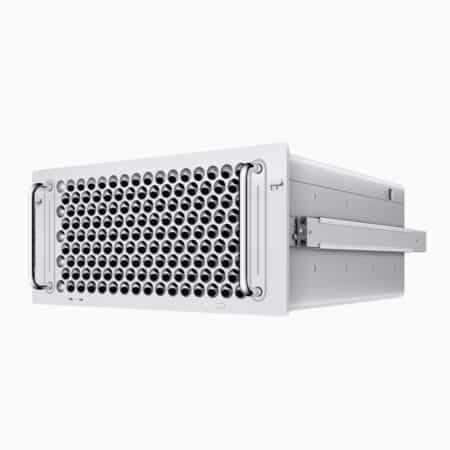Apple has finally brought Apple Silicon to the last Mac product—the Mac Pro tower. The new professional tower workstation delivers something that Mac Pros were so unhappy about in the past—lack of flexibility.
New Mac Pro
The new Mac Pro comes with the M2 Ultra SoC chip. This chip was also announced for availability inside the latest new Mac Studio computers also introduced today.
The new M2 Ultra chip is Apple’s most powerful custom Apple Silicon. ARM architecture-based and a complete SoC (system on a chip), the M2 Ultra combines the CPU, GPU, Neural Engine, caches, and system memory all on the same piece of silicon. While rumors have speculated about Apple delivering a monster-sized version of one of the M-series chips as the main chip on the Mac Pro, the company hasn’t taken that approach.

Apple finally brings Apple Silicon to workstation-class PCIe expansion. While not a machine for CAD and BIM users, the new 2023 Mac Pro combines the sheer power of the M2 Ultra chip with loads of cutting-edge expansion options and up to 192 GB of unified memory.
This will no doubt disappoint hardcore professional Mac users who were hoping for something truly extraordinary. What Apple has delivered instead is much more prosaic. The good news, however, is that finally has Apple Silicon inside its full-featured and expandable Mac Pro workstation.
Key Specs for Mac Pro
Here are some of the key performance specs of the new Mac Pro:
- M2 Ultra SoC chip (24 cores)
- 64 (Base) to 192 GB total system memory
- 16 Performance Cores
- 8 Efficiency Cores
- 60 – 76 GPU Cores
- 30 – 32 Neural Engine Cores
- 1 TB (SSD in Base model) to 8TB
- 6x full-length PCIe Gen4 slots
- 1x half-length x4 PCIe Gen3 slot with Apple I/O card installed
- 300W aux power
The new Mac Pro also features a Media Engine with the power of seven Apple Afterburner cards on silicon for hardware-accelerated H.264, HEVC, ProRes, and ProRes RAW. There are 2x video decode engines, 4x video encode engines, and four ProRes encode and decode engines.

Apple’s new Apple Silicon powered Mac Pro comes in a rack-mounted version. This machine will likely find many customers in film and special effects studios, science and medicine, and government agencies running specialized software.
The tower model starts at USD 6,999, and the rack model at USD 7,499. Prices rise with upgraded specs. The Mac Pro ships starting 13 June 2023.
To learn more about the Mac Pro, you can go here.
Architosh Commentary and Analysis
OTOY’s Octane X renderer is a GPU-accelerated rendering software application. The Mac Pro with M2 Ultra and 60-core GPU (not even the 76-core GPU) is up to 7.6x faster than the previous version with 8-core Intel Xeon W and Radeon Pro W5500X GPU. If you configure the previous Intel Mac Pro with a 28-core Intel Xeon W and outfit the workstation with the available Radeon Pro W6900X, the same Apple Silicon-based new Mac Pro is still 2.7x faster on the same OTOY Octane render. Other performance differences can be found here. The Autodesk Maya comparison is also quite substantial in the performance difference.
In terms of raw performance, the M2 Ultra doesn’t yet have Geekbench processor scores up on the site (as of this writing). However, the M2 Max found in the 2023 16-inch MacBook Pro has a single core (SC) score of 2729. As a point of comparison, the Geekbench score for the last Mac Pro model (2019 Mac Pro with Intel Xeon, 28-core) has a score of 1377. The fastest processor on the Geekbench board is the Intel Core i9 (13900 KS), with a score of 3083. The AMD Ryzen 9 7950X has a score of 2874.
Apple states that the M2 Ultra is 40 percent faster than the M1 Ultra found in the first generation of the Mac Studio. That chip at Geekbench has an SC score of 2378. If we increase that by 40 percent, we can estimate the Geekbench SC score at 3329. That would mean the new M2 Ultra would be the Geekbench industry leader for single-core performance.
Architects and other CAD and BIM users may feel disappointed that this machine is so expensive. They need to realize that this machine isn’t built for their industry. The big trade-off with macOS versus Windows in the AEC industry is now coming down to a single question: do you want upgradable GPU cards for the future?
It isn’t a question about performance anymore. Apple Silicon Macs today easily compete with the fastest PC computers. This new Mac Pro features the same exact M2 Ultra that can be found inside the new Mac Studio, which starts at USD 1,999 (for M2 Max) or USD 3,999 (for M2 Ultra).
The Mac Pro user is spending an additional USD 2,000 for the workstation tower enclosure with state-of-the-art I/O (input/output) and expansion capabilities. Given the price of the kinds of PCIe cards that might go in a new Mac Pro, that cost is trivial.



Reader Comments
Comments for this story are closed